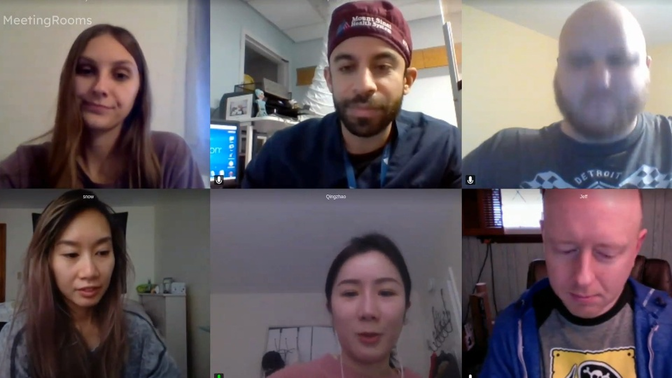
Unmoderated focus groups

Have you ever wondered what customers say about your brand behind closed doors? With unmoderated focus groups, you can receive just this. This qualitative research method enables your customers to have conversations with one another about your products, services, and overall brand experience—without a moderator present. And since study participants interact solely amongst themselves, the candid nature of these conversations gives researchers deeply charged, emotional insights. These are the insights you need to ensure that your experiences hit the mark every time.
Why unmoderated focus groups are key for turning good experiences into great ones
Customers don’t make purchase decisions in a vacuum. Instead, they’re influenced by their interactions with other consumers who may be making similar purchases. Researchers only need to consider the presence of customer reviews to see the value customers place on others’ opinions and feedback.
The weight of customers’ opinions on purchase decisions is borne out by data. According to a ReviewTrackers study, 94% of respondents claimed that negative reviews by other customers caused them to avoid a business.
By having your customers speak to one another about your products, services, and brand experience, without feeling the need to please the researcher, you can get ahead of negative reviews by stopping them in their tracks. Utilize their unfiltered feedback to curate experiences that’ll leave them raving rather than ranting.
Lawrence Williams, Solutions Consultant at UserTesting says, “It’s not about ripping and replacing your current method but adding in this one layer into the great work you’re already doing.”
When to choose an unmoderated focus group over a moderated focus group
You may have already decided that a focus group is best suited for your needs over other types of studies. Either you need to balance out your quantitative research with some qualitative insights, or the test you need requires deeper probing than traditional unmoderated testing can offer. But which type of focus group should you choose?
Moderated remote focus groups are similar to traditional in-person focus groups; however, they’re conducted remotely via video conferencing. It involves a moderator asking a group of people about their behaviors, preferences, attitudes, and experiences on a topic.
Some of the benefits are the chance to steer the conversation and ask follow-up questions. However, one of the most common challenges with moderated focus groups is that the presence of a researcher can cause biases in the group dynamics. Rather than being candid, participants may feel the need to watch what they say, potentially thinking:
- I don’t want to hurt the moderator’s feelings.
- I should tell the moderator what they want to hear.
- I want to increase my odds of being asked to participate in another study.
Even if participants aren’t deliberately biasing their responses, this can be an issue due to the feeling of a moderator watching over their shoulder. Additionally, groupthink could be at play, where participants think they must agree with others and don’t want to voice a differing opinion. And since you want to approximate a peer-to-peer, review-sharing session, this sort of influence could undo the very candor that you’re hoping to achieve.
Thus, a remote, unmoderated focus group may be preferred as participants are less likely to hold back their genuine thoughts, and you can receive insights from multiple sources in one session alone. Additionally, if your team is tight on budget or time, not including a moderator can also preserve bandwidth and efforts.
And during a moderated focus group, a researcher typically asks each participant for insights one by one. But with an unmoderated focus group, contributors are encouraged to engage with one another freely, placing more emphasis on their feedback, thought process, and why they think a certain way. Users can lean on each other if they get stuck and echo or dispute others’ feedback. Hearing this candid feedback can help surface the very kinds of comments or reviews they may leave online.
And remember, even if you opt for an unmoderated focus group over a moderated one, it doesn’t have to be the only type of testing you conduct. More often than not, your test can’t be encapsulated in one study or one kind of study alone. As a rule of thumb, most tests should be complementary, not competitive.
When should organizations conduct unmoderated focus groups?
While you can and should run this type of session on live products and experiences, running this earlier in the development cycle is optimal. Since this method is designed to get customers to speak candidly, getting their feedback on early-stage concepts and designs can help you avoid negative sentiment altogether by surfacing it before product launches even occur. Planning this step early helps prevent rework and ensures your development timeline stays on schedule.
The best practices for running unmoderated focus groups
You might be wondering—how can a remote, unmoderated focus group run smoothly when there's no researcher present to introduce the questions and guide the conversation? But don't fret; there are multiple best practices you can put in place to ensure the session runs as expected.
Before the unmoderated focus group
With most unmoderated tests, you can simply use screener questions to find your target audience. But with focus groups, you can kick it up a notch with a recruitment "interview"—which is part of what we consider the priming stage.
- Find your ideal audience members by filtering for your ideal criteria.
- Ask users to talk about themselves and their interests.
- Gauge their interest in the topic and willingness to participate in a conversation with their peers.
- Reiterate the conversation topic, date and time, and test invite.
- If applicable, have users visit a URL or offer materials they're expected to review or analyze during the focus group with their peers.
Similar to moderated focus groups, it’s recommended to keep the number of participants small to ensure everyone gets a turn to speak. For unmoderated focus groups, we suggest recruiting four to five participants. But during this initial stage, oversampling is recommended in the initial test, as some contributors may have other commitments at the allotted time or simply may not want to participate.
Now that your users are primed, ensure that you actually schedule a follow-up test, recruiting only those individuals who’ve agreed to participate in this test.
During the unmoderated focus group
The time has come! During the focus group, ensure that the following happens:
- Refresh contributors on what they’ll be talking about via a scenario. Since no moderator will be present, you’ll want to make your instructions are clear and leave no room for interpretation.
- Provide contributors with any URLs that are needed for the study.
- Send users to the virtual meeting room where they’ll chat with other contributors.
- Offer clear instructions for what contributors should do once they enter the meeting room, and list out all the questions they should discuss with their peers.
- Ask any relevant follow-up questions, such as:
- How would you rate the quality of the conversation you just had?
- Is there anything you wanted to say to the group but didn’t?
Watch UserTesting contributors participate in an unmoderated focus group
To see a remote, unmoderated focus group in action, watch the below video. UserTesting asked contributors to draw out their ideal Valentine's Day gift individually. Then, participants brought their pictures to the next session and conducted a show-and-tell. This unmoderated focus group revealed strong sentiments about what this holiday means to people and their preconceptions about gift recipients' expectations.

Getting started
As technology advances and customers become increasingly selective about the brands they interact with, human insight is all the more critical. To bridge the experience gap, understand when the right types of testing should be used and how they can be bridged. With unmoderated focus groups, you don't have to choose between learning how customers act independently and analyzing how social influence impacts users' choices. By including this social layer of data on your customers in your analyses, you can understand what drives their behavior individually and as part of a group.
For further information, view this free webinar on unmoderated focus groups, where you’ll learn how to structure and design better research sessions, leverage results, and more!

UX resource collection
Explore UX best practices, expert advice, user research templates, and more.





